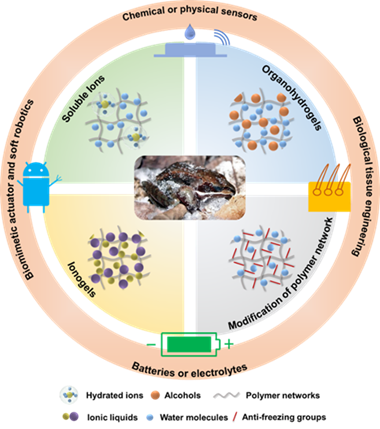A research group led by Prof. Chen Tao at the Ningbo Institute of Materials Technology and Engineering (NIMTE) of the Chinese Academy of Sciences (CAS) systematically summarized the recent research progress of biomimetic anti-freezing polymeric hydrogels and discussed the related mechanisms in depth, in cooperation with Zhou Xuechang’s research group from Shenzhen University (SZU). The review was published in Materials Horizons.
Hydrogel is a material that contains large amounts (up to 90%) of water, and has a specific shape. This structural feature is very similar to the in vivo counterpart, thus has attracted great interest of researchers. In addition, the coexistence of toughness and elasticity enables the utilization and applications of hydrogels in various fields. However, due to that the high water content freezes at sub-zero temperatures, hydrogels lose their excellent properties, like conductivity, transparency, flexibility, etc., limiting their real-life application.
Inspired by freezing resistance of biological organisms, researchers have synthesized biomimetic anti-freezing hydrogels, which can keep soft-wet materials active in cold environments. Researchers at NIMTE systematically reviewed the previous relevant studies, pointed out that there are three different states of the water molecules in hydrogels: "free water" that can move freely, "weakly bound water" that has little interactions with hydrophilic groups, and "Strongly bound water" that has very strong interactions with the gel network, which can maintain its mobility and thus its liquid state down -100 oC.
This provides theoretical guidance for the synthesis of anti-freezing hydrogels, including the introduction of solutes (i.e. salts, alcohols and ionic liquids) to alter the composition of “free water”, and modification of polymer networks (i.e., introduction of immobilized solutes).
In addition, the synthesis strategy employed for obtaining freezing resistance influences the properties of the resulting gels and their practical application, thus the researchers summarized the advantages and disadvantages of these strategies, providing suggestions for choosing the appropriate strategy to meet the real-life needs.
Moreover, various promising applications of anti-freezing hydrogels, like biomimetic actuators and soft robotics, chemical or physical sensors, batteries or electrolytes, etc. are introduced in detail.
Owing to that the functionality of the existing anti-freezing hydrogels remains relatively simple, the review can shed light on the further synthesis research of anti-freezing hydrogels in various fields, and offered outlook of hydrogels that can perceive and adapt to the environment autonomously, thus promoting the large-area hydrogel applications.
The work was supported by the National Natural Science Foundation of China (No. (21922303, 51873223, 51773215, 21774138), Youth Innovation Promotion Association of Chinese Academy of Sciences (No. 2017337, 2019297), and Key Research Program of Frontier Science, Chinese Academy of Sciences (No. QYZDB-SSW-SLH036) and K.C.Wong Education Foundation (GJTD-2019-13).

Fig. General synthesis strategies and application areas of anti-freezing hydrogels (Image by NIMTE)
Contact
JIAN Yukun
Ningbo Institute of Materials Technology and Engineering
E-mail: jianyukun@nimte.ac.cn

